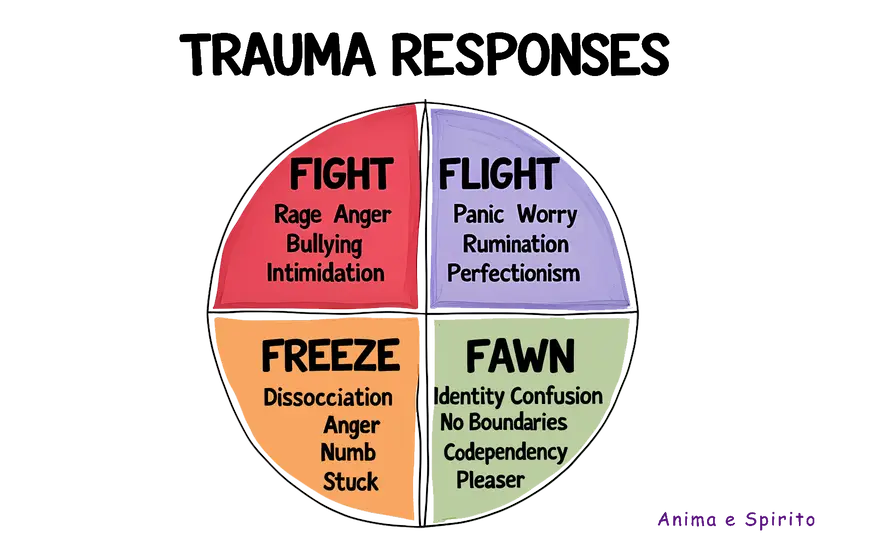Ever felt like your body has a mind of its own, especially after going through something really difficult? It’s like your brain hits the “panic button” even when things seem okay on the surface. Well, you are not alone! Our bodies are actually super smart and have their own ways of trying to protect us when life throws curveballs. Let’s talk about some of these reactions, which in therapy world, we often call “trauma responses.”
What Are Trauma Responses Anyway? Think of it Like a Survival Toolkit!
Imagine you’re a superhero (or just a regular person!) and suddenly, danger strikes. Your body needs to decide QUICKLY how to survive. It’s like it opens up a toolkit and pulls out the best tool for the job, without even asking your permission! These tools are our trauma responses. They are automatic reactions that happen when our brain perceives a threat, especially after we have lived through really tough or scary events – what we call trauma.
These responses are actually incredibly clever! They helped our ancestors survive dangerous situations way back in the day, and they are still kicking in for us now. Sometimes, though, these old survival tools can feel a bit confusing or even unhelpful in our modern lives.

The Famous “Fight” Response: Gotta Be Strong!
First up in our toolkit is the “fight” response. Think of it like becoming a warrior! When your body goes into “fight” mode, it’s getting ready to defend itself.
- Your heart might race like you’re about to run a marathon (even if you’re just sitting still).
- Your muscles tense up, ready to punch or kick (hopefully not your furniture!).
- You might feel angry, irritable, or on edge.
Basically, your body is saying: “Bring it on! I’m ready for a showdown!” This can be helpful if you are actually in danger and need to protect yourself physically. But sometimes, this “fight” response can pop up even when there is no real physical danger anymore, like in arguments with loved ones or feeling easily frustrated at work.
Examples of “Fight” Response in Daily Life
- Getting into arguments easily, even over small things.
- Feeling the need to always be in control.
- Being critical or judgmental of yourself and others.
- Having a short temper and feeling easily angered.
The “Flight” Response: Gotta Get Outta Here!
Next in our toolkit is “flight.” Think of it like becoming a super speedy runner! When your body goes into “flight” mode, it wants to escape the danger as fast as possible.
- You might feel restless and unable to sit still.
- Your mind might race, jumping from thought to thought.
- You might feel anxious or panicky.
It’s like your body is shouting: “Run! Get away! Danger is here!” This is super useful if you need to literally run away from a dangerous situation. But again, this response can become triggered in everyday situations that feel overwhelming or uncomfortable, even if there is no real physical danger.
Examples of “Flight” Response in Daily Life
- Avoiding situations or people that trigger uncomfortable feelings.
- Procrastinating or constantly staying busy to avoid dealing with things.
- Having trouble relaxing or feeling constantly on edge.
- Overthinking and worrying a lot.
The “Freeze” Response: Playing Possum!
Now we have the “freeze” response. Think of it like becoming a statue or playing possum! When your body goes into “freeze” mode, it shuts down and becomes immobile.
- You might feel numb, detached, or spacey.
- Your body might feel heavy or like you can’t move.
- Your mind might go blank, or you might feel disconnected from your surroundings.
It’s like your body is deciding: “If I can’t fight or run, I’ll just become invisible and hope the danger passes me by.” This response can be helpful in overwhelming situations where fighting or fleeing isn’t possible, like during a traumatic event. However, it can become a default response even in situations that are just stressful, leading to feeling stuck or disconnected.
Examples of “Freeze” Response in Daily Life
- Feeling “stuck” and unable to make decisions.
- Having difficulty concentrating or remembering things.
- Feeling emotionally numb or detached from feelings.
- Withdrawing from social situations and feeling isolated.
The “Fawn” Response: People Pleaser Extraordinaire!
Lastly, we have the “fawn” response. This one is a bit different. Think of it like becoming the ultimate people pleaser! When your body goes into “fawn” mode, it tries to appease the potential threat by being extra nice and helpful.
- You might prioritize other people’s needs and feelings above your own.
- You might have trouble saying “no” and overcommit yourself.
- You might seek approval and validation from others constantly.
It’s like your body is thinking: “If I can make this person happy, they won’t hurt me.” This response often develops in situations where a person feels dependent on someone who is also a source of threat, like in abusive relationships or neglectful families. It can become a pattern of constantly seeking approval and sacrificing your own needs in relationships.
Examples of “Fawn” Response in Daily Life
- Difficulty setting boundaries and saying “no.”
- People-pleasing and over-apologizing.
- Staying in unhealthy relationships to avoid conflict.
- Feeling responsible for other people’s feelings.
It’s All About Understanding and Healing
Understanding these trauma responses is the first step in healing. It’s important to remember that these are NORMAL reactions to ABNORMAL events. There’s nothing “wrong” with you if you recognize yourself in any of these descriptions. Your body is just doing its best to protect you, even if its methods are sometimes a bit outdated for modern life.
Therapy can be really helpful in understanding your own unique trauma responses and learning new, healthier ways to cope and feel safe in the world. It’s like updating your survival toolkit with some new and improved tools that fit your life today!






